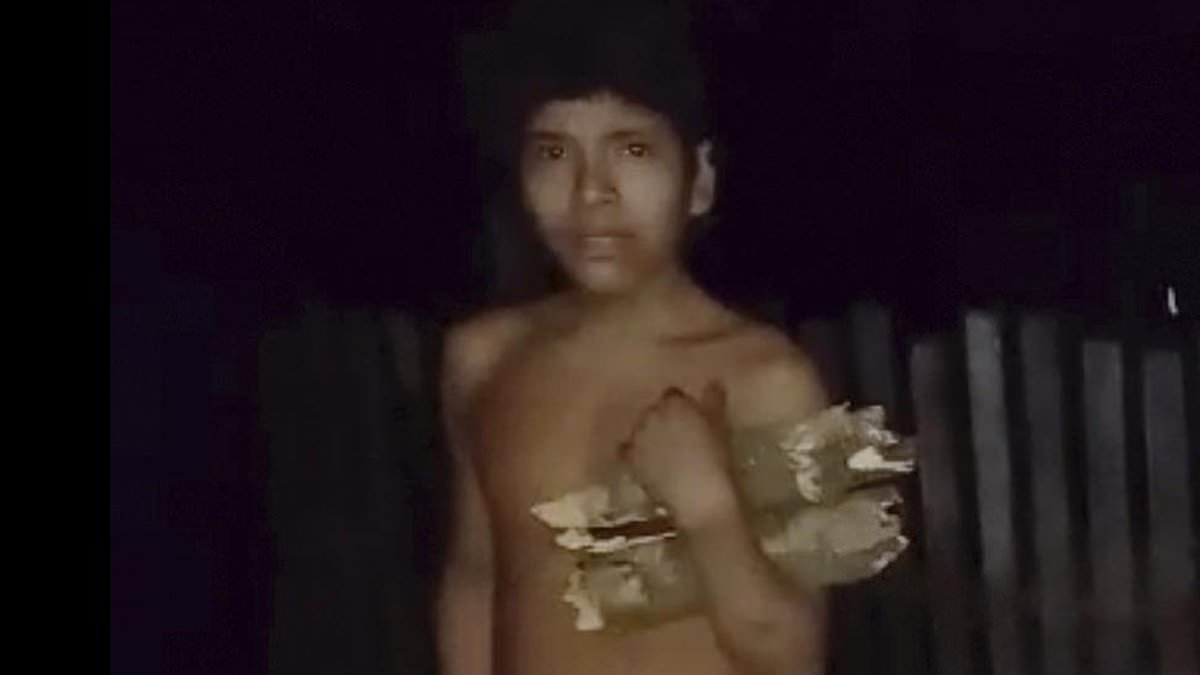A young Brazilian tribal member briefly strayed away his heavily isolated clan and mingled with the locals of a river community in a rare interaction.
The man was seen walking barefoot, wearing a small loincloth as he approached the residents of Bela Rosa, an area along the Purus River in the southwestern Amazon, on Wednesday around 7 pm local time.
He emerged from the Amazon Rainforest’s Mamoriá Grande – an area deemed off limits to non-indigenous people – holding two logs and was believed to be asking for help starting a fire. His demeanor was calm and he appeared to be healthy.
Cellphone footage reviewed by the Associated Press showed one resident trying to help the man use a lighter – but the attempt was unsuccessful.
Officials from Brazil’s Indigenous affairs agency, Funai, rushed to Bela Rosa to find the man before taking him to a facility to be evaluated.
They checked to see if he was exposed to any diseases that his tribe – which typically avoids non-Indigenous people – has little-to-no immunity to.
Funai added that additional authorities and monitoring efforts from their agency have been sent near the tribe’s land to prevent further contact with outside communities.
The young man was safely returned to the Mamoriá Grande Indigenous Land region, on Thursday afternoon, Funai said in a statement on Friday.

A young man from an isolated Indigenous tribe appeared on Wednesday in Bela Rosa, in Brazil’s Amazon

The man was seen walking barefoot, wearing a small loincloth as he approached the residents of Bela Rosa, an area along the Purus River (pictured) in the southwestern Amazon
Little is known about the tribe living in and around Mamoriá Grande. In August 2021, the Brazilian government had just gathered enough evidence to determine that native people living in the region even existed, according to Survival International.
Funai had found signs of life including shelters, woven baskets and pottery belonging to dozens of hunter-gathers in the western Amazon.
But Wednesday was the first time anyone from the tribe has been spotted, according to Spectrum News.
Since the tribe has lived remotely and has been virtually untouched by outside communities, Funai’s greatest concern is that the Indigenous group lacks immunity to Western diseases, and contracting the flu or a virus could be fatal.
In an effort to protect the tribe, Brazil passed a restriction of use ordinance in December 2024, Brazilian outlet O Maringa reported.
‘The measure aims to safeguard the lives of isolated indigenous peoples, who are extremely vulnerable to external pressures and environmental impacts,’ Funai said in a statement on Thursday.
This order of protection not only aims to prevent the spread of diseases, but is also centered around minimizing the chance of conflicts over land.
Under the ordinance, the tribe has been granted more legal support by the Brazilian government than they have been provided in previous years.

He emerged from the Amazon Rainforest’s Mamoriá Grande – an area deemed off limits to non-indigenous people – holding two logs and was believed to be asking for help starting a fire
According to Funai, the Mamoriá Grande area has a 20 percent overlap with the Médio Purus Extractive Reserve (Resex), which is publicly owned land.
The agency said they spoke extensively with Resex residents to ensure that the protective order benefitted their community along with the Mamoriá Grande tribe.
Brazil’s government does not generally go out of its way to make contact with Indigenous groups.
There are about 400 Indigenous and ethnic groups within the Amazon Rainforest – many of these tribes have not interacted with people other than themselves, according to World Wildlife.
In December 2024, astonishing photographs were taken of another uncontacted Amazon tribe.
The images, taken on automatic cameras, appeared to show the Massaco tribe arming themselves with machetes and axes that were left behind by Funai.

Non-Indigenous communities living along the Purus River (pictured) have had no interactions with the tribe prior to Wednesday
Funai has spent decades working to preserve the Massaco tribe’s area and ‘periodically’ leaves behind metal implements in a bid to deter uncontacted communities from venturing into farms or logging camps in search of tools.
The government body refers to the tribe as the Massaco after the river that runs through their lands, but it is unknown exactly how the tribe refers to themselves.
The group’s language, beliefs and social structure also remain a mystery, but the new photographs show the community appears to be thriving.
